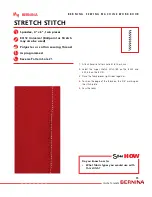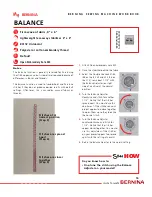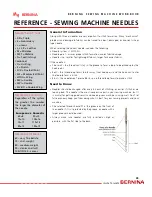
My
BERNINA
29
B E R N I N A S E W I N G M A C H I N E W O R K B O O K
Presser Foot
The presser foot/sole you select is critical for good results
because it can affect the way the fabric feeds under the
needle, influencing the stitch formation.
Usually the key to selecting the correct presser foot is the
bottom of the foot/bottom of the sole.
Stitches that are more open and have less thread will stitch
well with an all-purpose or zigzag presser foot.
• Reverse Pattern Sole #1 (Reverse Pattern Foot #1) has
small indentations in front of and behind the needle that
allow the fabric to move in a “back and forth” manner
when forming the stitches.
If you are creating heavy, satin stitched patterns, you will
need a foot that is not flat on the bottom. It should have
some type of indentation that allows the foot to ride over
the completed stitch without dragging or inhibiting the
feed of the fabric.
• Embroidery Foot #6 has a wedge-shaped indentation
behind the needle, perfect for allowing heavy compact
stitches to flow freely from under the back of the presser
foot.
• Open Embroidery Sole #20 (or optional Foot #20)and
optional Clear Embroidery Foot #39 both have the
same shape but the Clear Embroidery Foot offers more
visibility of the stitching area.
As you begin to experiment with decorative stitches on your
BERNINA machine, there are several things you should keep
in mind:
• Type of thread you plan to use
• Presser foot you select
• How you prepare your fabric
Type of Thread
Selecting the thread for decorative stitching often comes
down to a personal preference and what looks best on your
project.
Cotton embroidery thread, especially in a heavier weight
such as 30, gives a beautiful look to the stitches, has a nice
luster to it and fills in well.
If you want a high sheen, rayon or polyester embroidery
thread are good choices.
Preparing the fabric
Preparing your fabric correctly can take the frustration out
of your stitching, giving you a positive experience with
beautiful results. The fabric needs to be stable enough to
support the stitching without tunneling or puckering. This
can be accomplished in several ways, sometimes with a
combination of techniques:
• The fabric itself might be heavy enough to support the
stitching.
• Interfacing (fusible or sew-in) can be applied to the
wrong side of the fabric and left in the project.
• Stabilizers are used as a temporary form of support.
For the exercises in this class, you will be using light-
weight tear away stabilizer that can be removed after
stitching if desired.
REFERENCE - DECORATIVE STITCHING
















